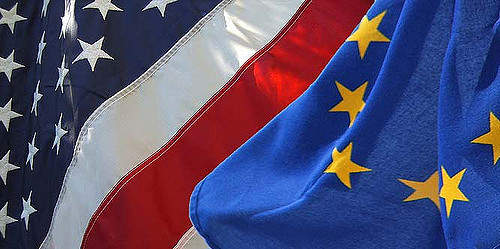The US vs China trade war is quickly becoming the US vs the world as President Trump's March tariffs on a number of close allies has sparked ongoing retaliation from those affected, culminating today (22 June) after the EU placed 2.8bn euros (£2.4bn) worth of duty increases on American imports

Everything from sweetcorn to makeup remover will cost more to import into Europe from the US following EU tariffs on 2.8bn euros (£2.4bn) worth of goods imposed today (22 June).
The move was me in response to President Donald Trump‘s March introduction of 25% steel and 10% aluminium tariffs, which affected EU exports worth 6.4bn euros (£5.6bn).
It was unanimously agreed upon by EU member states on 14 June and was approved by the World Trade Organisation (WTO), which allows countries to redress the economic imbalance themselves in cases such as this.
European Commissioner for Trade Cecilia Malmström said: “This is a measured and proportionate response to the unilateral and illegal decision taken by the United States to impose tariffs on European steel and aluminium exports.
“What’s more, the EU’s reaction is fully in line with international trade law. We regret that the United States left us with no other option than to safeguard EU interests.”
Trump’s tariffs
The President’s initial tariffs went ahead on 1 June and affect Canada, Mexico, India and other US allies in addition to the EU.
The reasoning for his hefty export price hikes is that the global oversupply of steel and aluminium, primarily accounted for by the Chinese, is threatening vital American producers of those materials.
More than that, the US trade deficit has risen over the last few years, currently running at about $50bn (£44bn) as American consumers are buying more products from outside their country – Trump’s tariffs are intended to counteract this trend.
The world has reacted strongly.
From 4 August, India will raise taxes on 29 products, including steel and iron, as well as almonds and chick peas in response.
Canada, too, will be placing response tariffs on £9.5bn worth of US exports starting 1 July.
Additionally, Mexico imposed tariffs on $3bn (£2.2bn) worth of US goods including steel, pork and bourbon whiskey, on 8 June.

And Trump’s move did little to calm pre-existing tensions with China.
Indeed, the President threatened to put 10% duties on a further $200bn (£150bn) worth of Chinese products earlier this week should the country not change its trade practices.
In a display of public recrimination, China accused the US of blackmail, and said it plans to retaliate with stronger counter-measures.
The EU’s response
The list of products the EU plans to place retaliatory tariffs on is extensive, and its split into two groups: Annex 1 and Annex 2.
Annex 1 came into effect today, comprising 10% and 25% additional duty fees on rice (25%), playing cards (10%), multiple steel products (all 25%), sail boats and yachts (25%), and tobacco (25%), among others.

The latter will be introduced on 1 June 2021 or after confirmation from the WTO is secured, whichever comes first.
It includes but is not limited to 10%, 25%, 35% and 50% duty hikes on cranberries (25%), textile fabrics (10%), kitchenware (50%), and articles of jewellery (25%).
The EU’s tariff choices appear to be politically motivated.
For example, the 25% tariff on orange juice will impact its main exporter, Florida, which happens to be a precarious swing state for Trump and one in which an economic downturn could generate political disdain for the President.
The US department of commerce is currently working on securing exemption for certain tariffs – known as a product exclusion process – where US importers can apply for specific products to be immune to the increased duty fees.
In light of the new trade counter-measures, the UK Government has said: “We will continue to work closely with the EU Commission to ensure that UK Business interests are firmly represented.
“DIT [Deparment for International Trade], BEIS [Department for Business, Energy, and Industrial Strategy, and HMRC [HM Revenue and Customs] met with UK businesses on 20 June to discuss matters further and will hold a second meeting on 25 June.”


